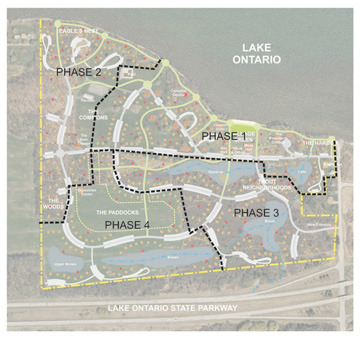Cottages at Troutburg three-season resort complex plans approved
by William Matthias
 After more than a year of review, the Town of Kendall has approved the site plan for the Cottages at Troutburg development, a future three-season resort complex at the “Camp Troutburg” site, a piece of land previously owned by The Salvation Army.
After more than a year of review, the Town of Kendall has approved the site plan for the Cottages at Troutburg development, a future three-season resort complex at the “Camp Troutburg” site, a piece of land previously owned by The Salvation Army.
Along with the approval, the town rezoned the property from four separate parcels into a WPDD (Waterfront Planned Development District) under a local law passed last year.
The approval of the project faced considerable resistance from a small group of residents within the abutting Norway Heights neighborhood who are dissatisfied with the town’s review of the site plan.
The developer of the project, The Wegman Group, was waiting for final approval before officially purchasing the property, which it did in late December. Construction at the site is expected to begin this spring, with an opening date in June, said Dave Wegman, the company’s CEO.
Full build-out of the 400-unit complex is expected over the next five years.
“We will retain the natural ambience the property possesses now,” Wegman said. “We’ve hired licensed, professional engineers and attorneys to the cost of hundreds of thousands of dollars to ensure that we follow all (applicable) laws, and that we are building in an environmentally-friendly manner.”
The Kendall Town Board in late November unanimously voted to issue a “negative declaration” for the project under the State Environmental Quality Review Act (SEQRA), determining that the development would not have any large, adverse impacts on the environment. SEQRA requires the town to assess many environmental factors related to development – including impacts on traffic, air quality, wetland and erosion. The town board also produced a 16-page report, as part of its “consistency review,” concluding that the project is compatible with the Kendall-Yates-Carlton Local Waterfront Revitalization Program.
A favorable report on the project was also compiled by The Orleans County Planning Board. The board stated that The Wegman Group has been “very responsive,” and with its plans, “there are few of the ambiguities that can plague other projects … with extensive lists of conditions to resolve.” It also commended Kendall’s town and planning boards for “their diligence in exercising their oversight roles.”
Wegman pointed out that revisions to the original site plan include plans for thorny bushes along the western boundary “buffer zone,” with an extension of the setback from Norway Heights from 10 feet to 50 feet. They also include the addition of two more fire hydrants, one being a dry hydrant – which could pull from nearby ponds if needed – as an added precaution.
The town’s engineering firm, Labella Associates, P.C., projected the available fire flow (water available at hydrants) at about 600 to 620 gallons per minute. This fire flow rate does not meet the State Insurance Services Office (ISO) guidelines. The firm pointed out, however, that under the state’s “Recommended Standards for Waterworks,” there are acceptable “deviations subject to individual consideration,” according to a letter from the firm.
Gary Zinsmeister, Deputy Chief of the Morton Fire Company, reviewed and approved of the private water distribution plans, with the exception one of the added hydrants being necessary. He said that with the development established, the current number of volunteers could handle the services required, according to minutes from a town board work session.
The Monroe County Water Authority had previously commented on the effect of the development on the existing water system, stating in a letter to the town that it “should not be noticeable to the existing water customers of the system.”
Despite the local government’s determinations and The Wegman Group’s revisions, residents of Norway Heights continue to express adamant disapproval of the development. They cite what they perceive to be a host of potential problems associated with certain aspects of the site plan, including the on-site sewage treatment plant and the fire pits planned for the cottage community.
Two of these residents are Missy Pixley and her husband, Dan. Missy said given the type, size and location of the development, the town should have conducted a “thorough environmental-impact study” before approving the project.
“I don’t see how this project was allowed to move forward without one,” she said. “There were too many open-ended questions (left at the time of approval). How is the sewage treatment plant going to affect the environment? How is the development going to affect the availability of water within water district No. 5? And what about the emergency access issues?”
Dan Pixley said he is particularly troubled with the town’s project review process.
“The planning board’s resolution (referral) seemed to have caught even the planning board off guard. It was supposed to have contained all related questions and concerns, which it did not.”
Bruce Newell, a former planning board member, agreed with Dan Pixley. He said there was an urgency to approve the project with “pressure from the town board and the town supervisor to get it done.” In an email message, Newell expanded his explanation: “It can also be noted that it took the town supervisor more than a week to transmit the submitted plan to the town’s consulting engineers which delayed the overall process and consumed a significant portion of the allotted 62 days.”
“Yes, I voted for the plan to move forward, but based on comments made by the planning board chair and the town supervisor, I thought we would have more time to complete the official referral document,” Newell said. “I was politically out-maneuvered.”
Newell resigned from the planning board on December 31, but declined to comment on the reasons behind his resignation.
The planning board’s recommendations included that “the site plan be updated to comply with all agreed modifications during the planning board’s review.” Newell said there wasn’t adequate time to compile a comprehensive list of modifications. In an email message, Newell further stated: “While the planning board was aware of the project since August 2011, serious evaluation of the proposal did not start until completion of the WPDD Law and submission of the final plan in August 2012.
Town Supervisor Dan Gaesser said this is a planning board issue and Newell’s statement about “politics” is “naïve.”
“Keep in mind that the town was first made aware of the project in August of 2011 – 15 months ago,” he said. The only ‘pressure’ they (planning board members) felt was the 62-day legal requirement to get the work done following The Wegman Group’s application submission under the WPDD law.”
Since the Salvation Army is a nonprofit, charitable organization, the property The Wegman Group purchased was tax exempt (with the exception of a water district tax) for more than 50 years. According to town records, The Wegman Group’s local tax bill for 2013 totals $98,681, which includes the water tax. The water tax bill for the property in 2012 was about $11,856.
“We are already seeing the benefits of this project,” Gaesser said.





